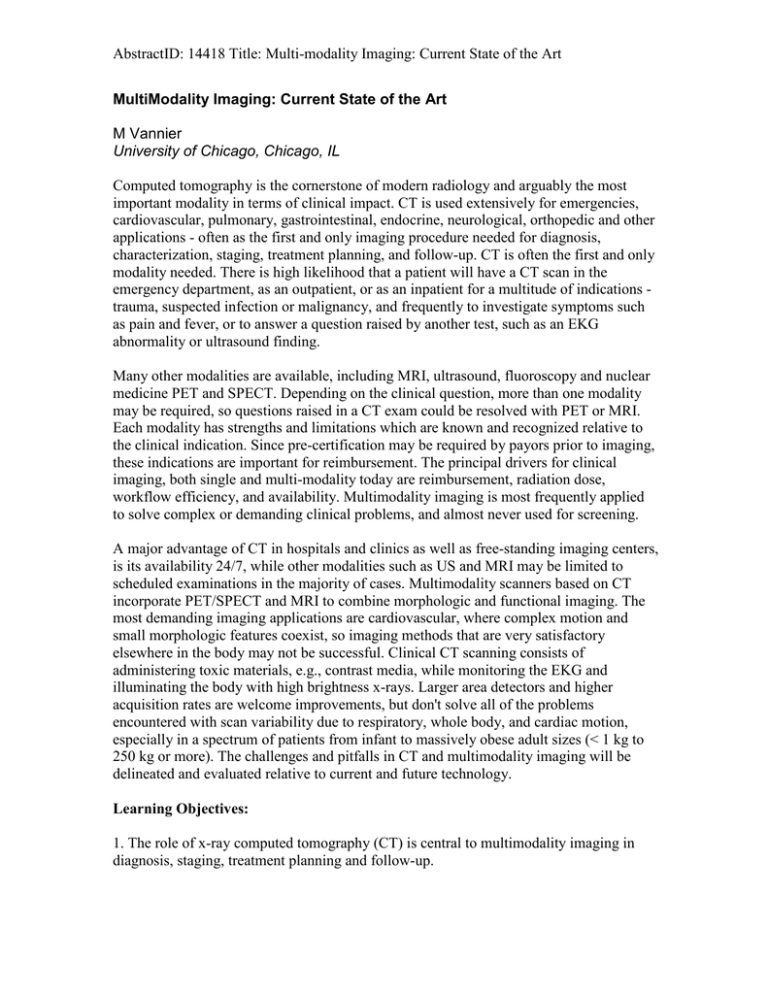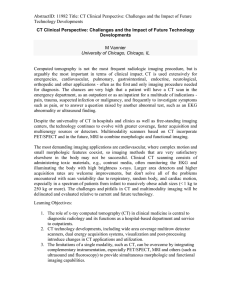AbstractID: 14418 Title: Multi-modality Imaging: Current State of the Art
advertisement

AbstractID: 14418 Title: Multi-modality Imaging: Current State of the Art MultiModality Imaging: Current State of the Art M Vannier University of Chicago, Chicago, IL Computed tomography is the cornerstone of modern radiology and arguably the most important modality in terms of clinical impact. CT is used extensively for emergencies, cardiovascular, pulmonary, gastrointestinal, endocrine, neurological, orthopedic and other applications - often as the first and only imaging procedure needed for diagnosis, characterization, staging, treatment planning, and follow-up. CT is often the first and only modality needed. There is high likelihood that a patient will have a CT scan in the emergency department, as an outpatient, or as an inpatient for a multitude of indications trauma, suspected infection or malignancy, and frequently to investigate symptoms such as pain and fever, or to answer a question raised by another test, such as an EKG abnormality or ultrasound finding. Many other modalities are available, including MRI, ultrasound, fluoroscopy and nuclear medicine PET and SPECT. Depending on the clinical question, more than one modality may be required, so questions raised in a CT exam could be resolved with PET or MRI. Each modality has strengths and limitations which are known and recognized relative to the clinical indication. Since pre-certification may be required by payors prior to imaging, these indications are important for reimbursement. The principal drivers for clinical imaging, both single and multi-modality today are reimbursement, radiation dose, workflow efficiency, and availability. Multimodality imaging is most frequently applied to solve complex or demanding clinical problems, and almost never used for screening. A major advantage of CT in hospitals and clinics as well as free-standing imaging centers, is its availability 24/7, while other modalities such as US and MRI may be limited to scheduled examinations in the majority of cases. Multimodality scanners based on CT incorporate PET/SPECT and MRI to combine morphologic and functional imaging. The most demanding imaging applications are cardiovascular, where complex motion and small morphologic features coexist, so imaging methods that are very satisfactory elsewhere in the body may not be successful. Clinical CT scanning consists of administering toxic materials, e.g., contrast media, while monitoring the EKG and illuminating the body with high brightness x-rays. Larger area detectors and higher acquisition rates are welcome improvements, but don't solve all of the problems encountered with scan variability due to respiratory, whole body, and cardiac motion, especially in a spectrum of patients from infant to massively obese adult sizes (< 1 kg to 250 kg or more). The challenges and pitfalls in CT and multimodality imaging will be delineated and evaluated relative to current and future technology. Learning Objectives: 1. The role of x-ray computed tomography (CT) is central to multimodality imaging in diagnosis, staging, treatment planning and follow-up. AbstractID: 14418 Title: Multi-modality Imaging: Current State of the Art 2. The principal drivers for CT and complementary use of other modalities are availability, reimbursement, workflow, and radiation dose. The influence of these factors on clinical decision making will be outlined and illustrated. 3. The limitations of a single modality, such as CT, can be overcome by integrating complementary instrumentation, especially PET/SPECT, MRI and others (such as ultrasound and fluoroscopy) to provide simultaneous morphologic and functional imaging.

